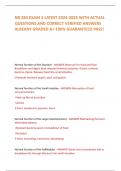NR 283 EXAM 3 LATEST 2024-2025 WITH ACTUAL
QUESTIONS AND CORRECT VERIFIED ANSWERS
ALREADY GRADED A+ 100% GUARANTEED PASS!
Normal function of the Stomach - ANSWER-Reservoir for food and fluid.
Breakdown and digest food released chemical enzymes. Gastric contents
become chyme. Releases food into small intestine.
Chemicals involved: pepsin, acid, and gastrin.
Normal function of the Small Intestine - ANSWER-Absorption of food
occurs(nutrients)
-Folds up like an accordion
-Lactase
3 Parts: duodenum, jejunum, ileum
Normal function of the Large Intestine(colon) - ANSWER-Maintaining fluid and
electrolyte balance.
-Resistant bacteria assist in breakdown of food
-Peristalsis
3 Parts: Ascending, transverse, descending
Normal function of the Gallbladder - ANSWER-Stores and concentrates bile to
breakdown fat through bile duct into small intestine.
,-Bile is made by bilirubin
Normal function of the Pancreas - ANSWER-Releases the most acidic enzymes.
Exocrine: posterior to stomach
Endocrine: Hormones
3 enzymes: lipase, trypsin, amylase
Normal function of the Liver - ANSWER--Makes protein
-Produces bile
-Stores sugar
-Removes dead RBC and free bilirubin
-Removes toxins from blood Ex: drugs and alcohol
-Called blood reservoir
-Synthesis cholesterol(to make hormones)
-Hepatocytes= "liver cells" which are the fastest regenerative cells.
Clinical manifestations of digestive disorders - ANSWER-Anorexia
Vomiting
Hematemesis
Bleeding
Pain
Diarrhea
Constipation
Dysphagia
Nausea
,GERD - ANSWER-Reflux of acid and pepsin from stomach to esophagus.
GERD causes - ANSWER--Sphincter malfunction
-Impaired esophageal motility
-Impaired gastric emptying
*30-40 min after eating
-Caffeine, alcohol, smoking, spicy diet
-Hiatal hernia
GERD S/S - ANSWER-Heartburn, acid regurgitation, dysphagia, chronic cough,
asthma, laryngitis, pain with 1 hour of eating.
GERD risk factors - ANSWER-Vomiting, obesity, and pregnancy
Gastritis - ANSWER-Inflammatory disorder of gastric mucosa
Gastritis causes - ANSWER-Drugs(NSAIDS), chemicals, H pylori(bacteria), injury
of protective mucosa
Gastritis S/S - ANSWER-Pain, nausea, vomiting, anorexia, and bleeding
Gastritis risk factors - ANSWER-Taking NSAIDS, age, and autoimmune disorders
Peptic ulcer disease - ANSWER-Break in the protective mucosal lining of lower
esophagus, stomach, or duodenum.
, Peptic ulcer disease causes - ANSWER-Injury to protective mucosa,
drugs(NSAIDS), chemicals, H. pylori
Peptic ulcer disease S/S - ANSWER-Pain, anorexia, vomiting, weight loss
Peptic ulcer disease risk factors - ANSWER-Taking NSAIDS, infection, alcohol,
smoking, age, chronic disease, type O blood, psychologic stress
Crohn disease - ANSWER-Idiopathic inflammatory disorders that affects any
part of the GI tract
Crohn disease causes - ANSWER-Chronic inflammation, skip lesions, fishers
tunnel,
-begins in mucosa and spreads to entire intestinal wall.
Crohn disease S/S - ANSWER-Remission and exacerbation.
-Bleeding, cramping, pain, urgency, frequent diarrhea, dehydration, weight
loss, anemia.
Crohn disease risk factors - ANSWER-Ages 10-30, smoking, family history
Ulcerative colitis - ANSWER-Chronic inflammatory disease that causes
ulceration of the colon mucosa
Ulcerative colitis causes - ANSWER-Chronic inflammation, unknown, mucosal
layer involved
Ulcerative colitis S/S - ANSWER-Remission and exacerbation.




